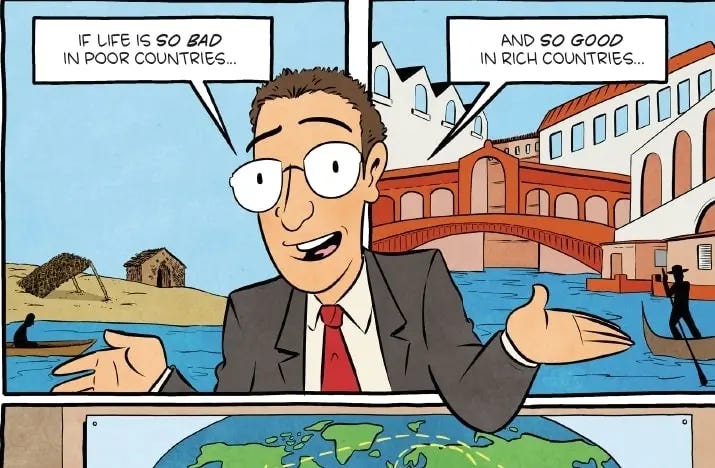Illustrating the Case for Unrestricted Immigration
By Daniel Griswold
So much of the immigration debate today consists of each side depicting the other with cartoonish characterizations. In his new book Open Borders: The Science and Ethics of Immigration, George Mason University professor Bryan Caplan has teamed up with an actual cartoonist to put forward an intellectually rigorous and graphically appealing case for the freer movement of people worldwide.
I’ve read a lot of books and papers on immigration over the years, but this book by Caplan and coauthor and artist Zach Weinersmith wonderfully combines comic-book storytelling with serious arguments and evidence. Over the course of 250 pages, including more than 30 pages of endnotes and references, Caplan makes a compelling moral and empirical case for more widely opening the borders of rich countries to poor immigrants.
Caplan marshals an armada of evidence, using charts, graphs and a few well-chosen figures to tackle the negative misconceptions about the impacts of immigration on wages, government finances, political divisions, and culture. He also prompts deeper consideration of the ethics of immigration, drawing from such diverse figures as Emmanuel Kant, John Stuart Mill, John Rawls, Robert Nozick, Jesus Christ, and Martin Luther King, Jr. Caplan’s argument comes alive with Weinersmith’s rich illustrations of historical events, metaphors, and with the appearance of a cast of characters sharing their research and perspectives “in person.”
I especially appreciated that Caplan is not afraid to tackle the more controversial aspects of the immigration argument. More open borders will result in millions more immigrants over time, mostly from poor countries. But those poor immigrants immediately become more productive when they move to a rich country like the United States. They also “quickly acculturate enough to become productive members of our society.” And their children typically achieve high levels of success.
On worries about terrorism and crime, Caplan presents evidence that, while foreign-born individuals are responsible for most terrorist acts in the United States since 1975, those acts are relatively rare compared to other dangers to public safety. And foreign-born individuals are less likely than native-born Americans to commit crimes or to be incarcerated.
As for concerns about the fiscal impact of immigration, Caplan draws on well-established research that most immigrants pay more in taxes than they consume in government services over their lifetimes. Even lower-skilled immigrants who come the United States at the beginning of their work careers do not impose a significant burden on taxpayers. He challenges Milton Friedman’s comment that we can’t have robust immigration and a welfare state.
Caplan also effectively bats back worries about immigration’s impact on culture and politics. He cites polling that shows that immigrants are learning English, just as in the past, and that their children are typically bilingual. He also cites research showing that immigrants are not that different than natives politically and are less inclined to be politically active. As Caplan sums up, “Cultural disintegration? Linguistic and social assimilation are very high and immigrants are more law-abiding than natives! . . . The end of freedom? Immigrants are more economically liberal and socially conservative than natives, but it’s a marginal difference and they rarely vote. Wherever you stand politically, it’s no big deal.”
The title of the book may invite some of Caplan’s critics to paint him as an extremist on immigration, but his arguments are nuanced and amenable to what he calls incremental “keyhole solutions.” A keyhole solution is one that seeks to address the concerns about immigration without tight restrictions on immigration inflows.
For example, concerns about the fiscal impact of immigration can be addressed by restricting immigrant access to government social programs. Or lower-skilled natives could be compensated for any reduction in their wages though payments financed by increased fees for immigrant visas. “While draconian enforcement of byzantine regulations is one way to solve social ills,” Caplan writes, “There’s almost always a ‘keyhole’ alternative that addresses the same problem more cheaply and humanely.”
Caplan concludes his narrative on the positive note: change is possible in ways that may seem impractical at the moment. He invokes the illustration of the “Overton window,” which is the term for the range of policy options that are available given current public opinion, arguing that advancing a more principled case for immigration will widen that window, creating a more hospitable climate for immigration reform. He points out that in the past 75 years, Europe has progressed from the devastation of two world wars and rampant nationalism to a European Union policy of free migration among its members.
In the midst of an immigration debate that’s especially heated and often vitriolic, the Caplan and Weinersmith book is a lively, colorful, thoughtful, and hopeful exposition of the issue in all its complexity. It may not change the minds of many of the more hardened immigration skeptics, but it has the potential to appeal to a broader audience of citizens trying to make sense of an issue that remains central to the American experiment.


